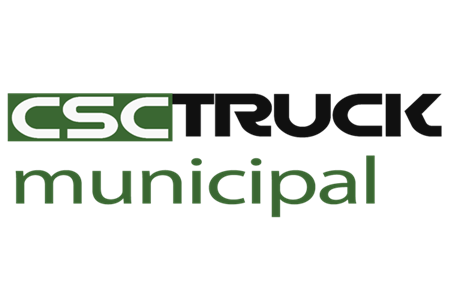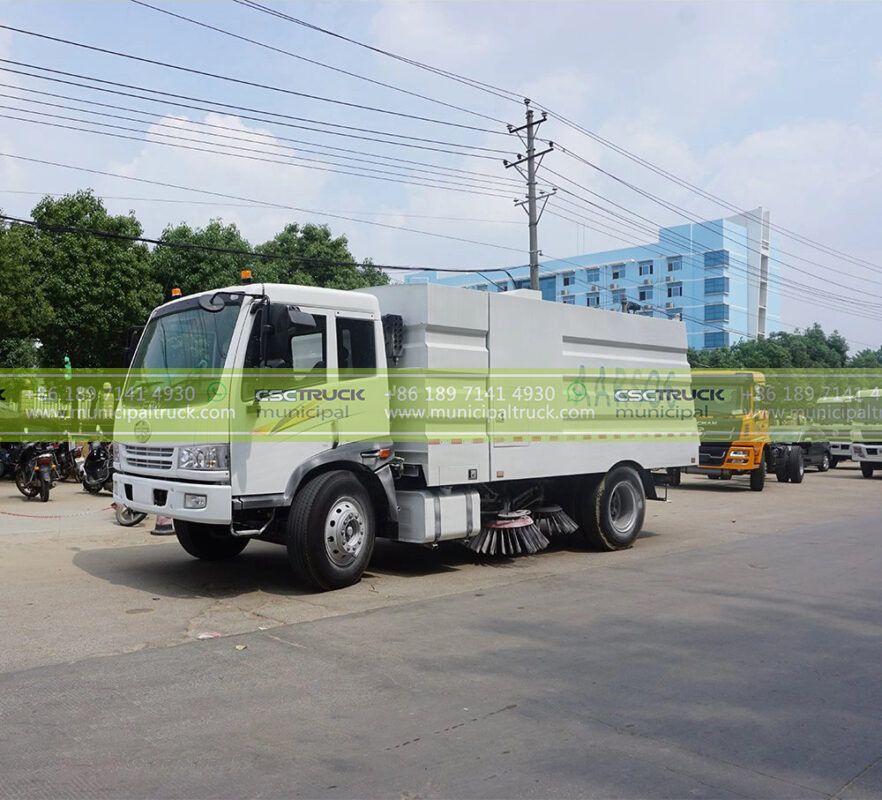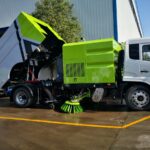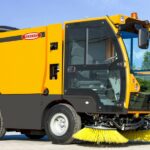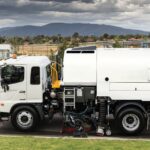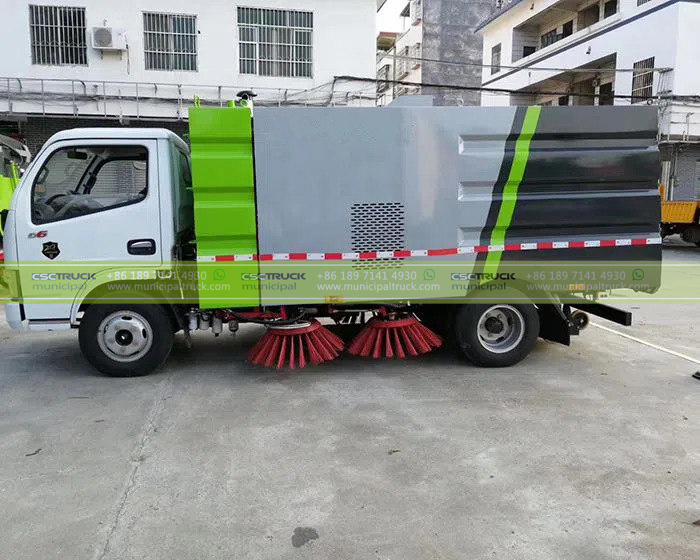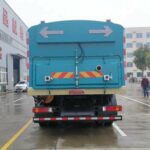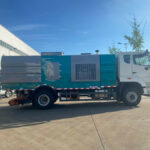The Sweeping Spectrum – Understanding the Operational Dichotomy
The quest for clean paved surfaces spans vast urban grids, sprawling industrial complexes, critical transportation networks, and sensitive environmental zones. While the image of street cleaning often conjures compact, nimble machines navigating tight city blocks, a significant segment of terrain presents challenges far beyond the capabilities of these smaller units. The choice between a compact sweeper and a full-size sweeper truck is not merely one of scale but of fundamental operational capability, dictated by the unique demands of the environment. Compact sweepers excel in confined spaces, low-to-moderate debris volumes, and pedestrian-heavy areas. However, when confronted with expansive territories, extreme debris loads, high-speed operations, structurally demanding surfaces, or specialized contamination control needs, the inherent power, capacity, endurance, and specialized features of robust road sweeper trucks become not just advantageous but essential. This analysis delves into the specific terrain challenges where opting for the substantial capabilities of a full-size sweeper truck is the only viable, efficient, and often safest strategy.
Conquering the Corridors of Commerce – High-Speed & High-Volume Networks
The arteries of commerce and travel demand uninterrupted flow and stringent safety standards, environments inherently hostile to compact sweepers.
- Highways & Expressways: Operating safely at speeds often exceeding 35-40 mph amidst fast-moving traffic is paramount. Full-size sweeper trucks are engineered with powerful engines, robust chassis, advanced aerodynamic considerations, and safety lighting/reflectivity packages specifically for this high-risk environment. Their significant weight and stability prevent dangerous buffeting from passing trucks. Crucially, their immense debris hopper capacity (often 8-16 cubic yards or more) allows for extended runs without constant, hazardous offloading stops on the shoulder. Compact sweepers lack the speed, stability, and capacity for effective highway work, presenting unacceptable safety and efficiency risks.
- Major Arterial Roads & Boulevards: While speeds may be lower than highways, the sheer debris volume generated by high traffic counts, combined with the need for efficient coverage over miles of roadway, necessitates the productivity of a large sweeper truck. Their wider sweeping paths cover more ground per pass, and their powerful suction and sweeping systems handle heavy accumulations of sand, gravel, tire shreds, and general litter efficiently. Stopping every few blocks to empty a compact hopper disrupts traffic flow and drastically reduces productivity on these vital routes.
- Logistics Hubs & Ports: Container terminals, intermodal yards, and busy port roadways contend with massive amounts of track-out debris – mud, gravel, wood dunnage, metal fragments, and spilled cargo. Full-size sweepers offer the brute force needed to dislodge compacted material and the hopper volume to manage the sheer tonnage generated. Their robust construction withstands impacts from stray debris common in these harsh environments, where compact models would be quickly overwhelmed and potentially damaged.
Mastering the Expanses – Large Paved Assets & Disaster Response
Scale itself can be the defining challenge, demanding endurance and coverage efficiency only large trucks provide.
- Airport Operations: The Need for Speed and Precision: Runways, taxiways, and vast aprons are perhaps the quintessential domain demanding full-size airport sweeper truck solutions. Foreign Object Debris (FOD) – any object not belonging on the paved surface – poses catastrophic risks to aircraft. Airport sweepers combine immense hopper capacity with the ability to operate safely at operational speeds (often 25-40+ mph) critical for clearing runways rapidly between aircraft movements. They feature specialized, often certified, magnetic systems for ferrous metals, powerful suction to lift small stones or debris, and stringent spark arrestment for fuel-laden environments. Compact sweepers lack the speed for efficient runway coverage and the capacity for large-scale apron cleaning after storms or events.
- Large Industrial Parks & Distribution Centers: Massive parking lots, miles of internal service roads, and expansive paved storage yards generate significant debris. Manually deploying compact sweepers across hundreds of acres is logistically impractical and inefficient. Large sweeper trucks cover vast areas quickly with fewer operator hours, their extended run times minimizing refueling and dumping interruptions crucial for maintaining site aesthetics and safety.
- Post-Disaster Debris Management: Following storms, floods, or earthquakes, roadways and critical infrastructure sites are littered with heterogeneous debris – mud, silt, branches, building materials, glass. Compact sweepers are quickly incapacitated. Full-size sweepers, often equipped with high-flow water systems for dust suppression and powerful regenerative air or mechanical broom systems, provide the muscle and capacity for rapid initial clearing and ongoing cleanup efforts essential for recovery operations.
Tackling the Tough Stuff – Heavy Industrial Sites & Construction Zones
These environments test equipment durability and contaminant-handling capability to the limit, favoring the robustness of trucks.
- Mines & Heavy Manufacturing: Sites with constant heavy vehicle traffic generate extreme abrasive loads (metal slag, rock fragments, heavy dust like cement or fly ash). Full-size industrial sweepers feature heavy-duty brooms, wear-resistant hoppers and conveyors, enhanced filtration systems, and powerful suction designed for continuous operation in punishing conditions. Managing the sheer volume of material requires large hoppers. Compact sweepers lack the necessary durability, filtration capacity, and debris volume handling for sustained operation here.
- Construction Site Egress & Haul Roads: Controlling track-out – the migration of mud, gravel, and debris from construction sites onto public roads – is a major environmental compliance and safety issue. Conditions are muddy, rocky, uneven, and constantly changing. Full-size sweepers, often with optional high-pressure pre-wash systems and aggressive broom configurations, are needed to break up and remove compacted, sticky mud effectively. Their stability on uneven terrain and ability to handle large rocks or chunks of concrete is crucial. Compact sweepers struggle significantly with heavy mud and large debris, making them ineffective for primary egress control on major projects.
- Demolition Sites: Cleaning post-demolition involves hazardous materials (nails, glass shards, asbestos-containing dust – requiring HEPA filtration), large chunks of debris, and pervasive fine dust. Robust sweeper trucks equipped with specialized debris confinement systems, high-efficiency particulate air (HEPA) filters, and impact-resistant components are essential for safe and compliant cleanup. Compact units lack the necessary filtration, confinement, and durability for safe operation.
Protecting Sensitive Surfaces – When Delicate Meets Demanding
Some surfaces demand powerful cleaning but cannot withstand aggressive mechanical action.
- Specialized Pavements: Expensive or delicate surfaces like decorative brick pavers, certain types of asphalt, or freshly sealed lots can be damaged by the concentrated downforce of mechanical broom compact sweepers. Regenerative Air sweeper truck models (common in larger configurations) primarily use powerful vacuum and air streams to lift debris, exerting far less direct physical pressure on the surface. This makes them the preferred choice for thorough cleaning without risking damage to vulnerable pavements.
- Dust-Sensitive Environments: Facilities like electronics manufacturing, pharmaceuticals, or food processing have near-zero tolerance for airborne dust generated by sweeping. Large sweeper trucks can be equipped with vastly superior filtration systems (multi-stage, including HEPA) and high-capacity water spraying systems for dust suppression far exceeding the capabilities of compact models. This level of environmental control is critical in sensitive zones.
Strategic Fleet Integration – The Municipal & Large-Scale Operator Calculus
For entities managing diverse terrain portfolios, the integration of full-size sweeper truck assets is a strategic operational necessity. Municipal public works departments, responsible for sweeping everything from narrow alleys to miles of high-speed highways, require both compact agility and truck-class power. A well-managed municipal truck fleet leverages compact units for dense urban cores while deploying full-size sweepers for arterial roads, highways, large parks, and post-storm recovery. Large contractors serving industrial clients, airports, or managing regional construction projects build their core capability around robust sweeper trucks, possibly supplementing with compacts for niche tasks. The decision hinges on total cost of ownership across challenging terrains: while the initial investment in a sweeper truck is higher, its superior productivity, durability in harsh conditions, reduced downtime for dumping, and ability to handle the most demanding jobs translate into lower cost per mile swept and greater operational resilience. Ignoring the terrain-specific capabilities of full-size sweepers leads to compromised safety, inefficiency, inadequate cleaning standards, and ultimately, higher operational costs when facing the challenges where only a truck will suffice. The right tool, wielded strategically, ensures clean, safe, and compliant surfaces across the demanding landscapes of modern infrastructure.
